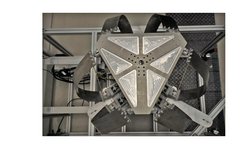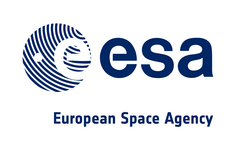ContinuumPKM
Demonstrator of Parallel Kinematics Continuum Mechanism for Robotic Exploration
The goal of the ContinuumPKM project is to leverage the advantages of parallel continuum mechanisms to develop a mechanism for future space missions. This innovative mechanism has the potential to replace traditional robotic arms in missions such as exploration, in-orbit servicing, and docking. To this end, we developed a novel 6-RUS parallel continuum manipulator system (PACOMA) featuring flexible links composed of a leaf spring-tendon system, which provides natural compliance and absorbs external collision forces. To control the robot, a kinetostatic model based on inverse kinematics is proposed, which effectively addresses the coupled problems between kinematics and statics, providing a real-time solution for PACOMA's operation under external force. Extensive tests have been conducted using a real PACOMA prototype to evaluate the system and modeling approach. Additionally, the application of PACOMA for docking with a space rover was investigated. The docking task was successfully conducted in a simulated lunar crater environment using a real four-wheeled space rover and two modular docking interfaces.
| Duration: | 01.01.2022 till 31.03.2024 |
| Donee: | German Research Center for Artificial Intelligence GmbH |
| Sponsor: | ESA |
| Grant number: | The project is subcontracted by Airbus Defence & Space GmbH (Grant No. D.4283.01.02.01) with funding from the European Space Agency (Grant No. ESA-TECMSM-SOW-022836). |
| Partner: |
Airbus Defence and Space GmbH, |
| Application Field: |
Underactuated Robotics
Space Robotics |
| Related Projects: |
Recupera REHA
Full-body exoskeleton for upper body robotic assistance
(09.2014-
12.2017)
|
| Related Robots: |
Sherpa
Expandable Rover for Planetary Applications
|
| Related Software: |
HyRoDyn
Hybrid Robot Dynamics
|
Project details
Parallel manipulators consist of a platform that is connected to a base by several kinematic chains or arms. These arms work together to control the position and orientation of the platform, offering advantages include high stiffness, accuracy, and the ability to carry heavy loads. However, it also comes with disadvantages of limited dexterity and workspace, and a constraint in the use of fast robots is the increased risk of damage and/or injuries due to operating at high speeds when in close proximity with other robots or humans.
Continuum manipulators, on the other hand, inherit the compliance from its material or structure, offering a safety interaction with the environment. In recent years, the parallel continuum manipulators were introduced to combine the advantages of parallel kinematic machines and continuum robots. Their main features comprise a good adaptability to the environment, due to both intrinsic compliance and changeable configuration for the same end-effector pose.
In space missions, this new mechanism has significant potential for various applications. Its inherent flexibility ensures safe interactions during contingencies, such as collisions with client satellites. The high stiffness in coupled configurations allows for efficient torque transmission to the client satellite. Additionally, mounting the actuators inside the base provides better protection from harsh and dusty space environments.
As a result, ContinuumPKM proposed and developed a novel parallel continuum Stewart robot, which with the end effector is connected by a leaf spring tendon modular. In this project, DFKI is primarily responsible for the development of the PACOMA software, including mathematical modeling, system control, performance testing, and exploration of potential application scenarios.
To control the robot with external contact forces, a kinetostatic model is proposed. Methods are developed to model the leaf-spring tendon system and integrate it into the parallel mechanism. Systematic experiments are conducted to investigate the limits of the new mechanism, including its robustness, capability to absorb external collisions, performance in position and force control, and workspace analysis for this constrained mechanism. To explore potential applications in space missions, the PACOMA robot is tested in a docking demonstration within simulated space scenarios. It manipulates a modular electronic interface (EMI), actively docking into the space rover "Sherpa" in a simulated lunar crater landscape.
In the series of tests, the PACOMA system demonstrated excellent manipulation capability, particularly its robustness under external collision forces. During docking experiments, it successfully completed docking tasks with minimal contact force by passively adjusting its shape to accommodate misalignment. Such misalignment typically requires highly precise control with traditional rigid mechanisms, which is challenging to achieve in complex real-space environments.
Videos
ContinuumPKM: PArallel COntinuun MAnipulator (PACOMA)

PACOMA is a flexible robotic system for space missions, using a spring-tendon design and RUS kinematics. It ensures precise control, stability, and safe docking interactions.
Publications
V. Rodrigues, B. Yu, C. Stoeffler, and S. Kumar, "Kinetostatic analysis for 6RUS parallel continuum robot using Cosserat rod theory," in Advances in Robot Kinematics 2024, J. Lenarčič and M. Husty, Eds. Cham: Springer Nature Switzerland, 2024, pp. 426–434. <Link>


